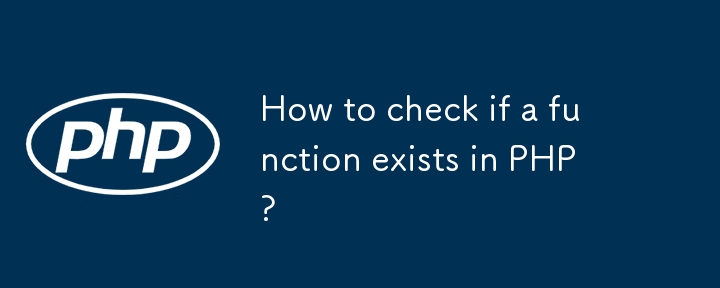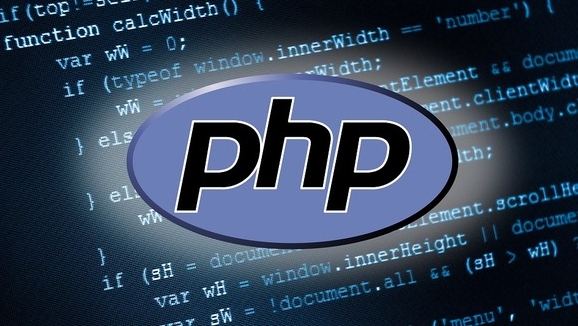To confirm whether the function is defined in PHP, you should use the function_exists() function and pay attention to its scope and limitations. This method determines whether it exists by passing in the function name string. It is suitable for user-defined functions, extended functions and functions in namespace (requires a complete path); but it is not suitable for class methods or language structures. For inspection of class methods or object methods, the method_exists() function should be used to pass the class name or object instance respectively. In addition, it is necessary to avoid misuse of language structures such as echo, ensuring accurate spelling of function names, and preventing repeated definitions.

In PHP, if you want to confirm whether a function has been defined and avoid errors caused by calling undefined functions, you can use the built-in function function_exists() . This method is simple and direct, but there are still some details to pay attention to when to use it.

1. Use function_exists() to check whether the function exists
This is the most commonly used and officially recommended method. function_exists() accepts a string parameter, representing the function name, and returns a boolean value.

if (function_exists('my_function')) {
my_function();
} else {
echo 'function is not defined';
}- ? Suitable for user-defined functions, extended functions, and functions in namespaces (note that you write the full name).
- ? Not suitable for checking class methods or language structures (such as
echo,print, etc.).
If you define a function in the namespace, remember to pass in the complete namespace path:
namespace MyNamespace;
function foo() {}
// if (function_exists(__NAMESPACE__ . '\\foo')) {
// ...
} 2. What should I do if function_exists() cannot be used?
Sometimes you may want to check for class methods or object methods, function_exists() is not applicable at this time.

Check whether the class method exists:
Use method_exists() function:
if (method_exists('MyClass', 'myMethod')) {
// MyClass::myMethod() exists}Check whether the object method exists:
You can also use method_exists() to pass in the object and method name:
$obj = new MyClass();
if (method_exists($obj, 'myMethod')) {
// $obj->myMethod() exists}Note:
method_exists()can only judge methods of classes or instances and cannot be used in ordinary functions.
3. Common misunderstandings and precautions
Don't use it to judge language structure
The writing method offunction_exists('echo')is wrong, becauseechois a language structure rather than a function, so it cannot be checked like this.Function name spelling should be accurate
Includes case and namespace prefix. Although the PHP function name itself is case-insensitive,function_exists()receives a string, and it is recommended to write it according to the actual name.Avoid repeated definitions
If you are loading functions dynamically in plug-ins or modules, it is best to combinefunction_exists()to prevent repeated definition errors.
Basically that's it. PHP provides several simple functions to help us safely deal with the existence of functions and methods. It is not complicated to use, but you should pay attention to the differences in different scenarios.
The above is the detailed content of How to check if a function exists in PHP?. For more information, please follow other related articles on the PHP Chinese website!

Hot AI Tools

Undress AI Tool
Undress images for free

Undresser.AI Undress
AI-powered app for creating realistic nude photos

AI Clothes Remover
Online AI tool for removing clothes from photos.

Clothoff.io
AI clothes remover

Video Face Swap
Swap faces in any video effortlessly with our completely free AI face swap tool!

Hot Article

Hot Tools

Notepad++7.3.1
Easy-to-use and free code editor

SublimeText3 Chinese version
Chinese version, very easy to use

Zend Studio 13.0.1
Powerful PHP integrated development environment

Dreamweaver CS6
Visual web development tools

SublimeText3 Mac version
God-level code editing software (SublimeText3)
 PHP Variable Scope Explained
Jul 17, 2025 am 04:16 AM
PHP Variable Scope Explained
Jul 17, 2025 am 04:16 AM
Common problems and solutions for PHP variable scope include: 1. The global variable cannot be accessed within the function, and it needs to be passed in using the global keyword or parameter; 2. The static variable is declared with static, and it is only initialized once and the value is maintained between multiple calls; 3. Hyperglobal variables such as $_GET and $_POST can be used directly in any scope, but you need to pay attention to safe filtering; 4. Anonymous functions need to introduce parent scope variables through the use keyword, and when modifying external variables, you need to pass a reference. Mastering these rules can help avoid errors and improve code stability.
 How to handle File Uploads securely in PHP?
Jul 08, 2025 am 02:37 AM
How to handle File Uploads securely in PHP?
Jul 08, 2025 am 02:37 AM
To safely handle PHP file uploads, you need to verify the source and type, control the file name and path, set server restrictions, and process media files twice. 1. Verify the upload source to prevent CSRF through token and detect the real MIME type through finfo_file using whitelist control; 2. Rename the file to a random string and determine the extension to store it in a non-Web directory according to the detection type; 3. PHP configuration limits the upload size and temporary directory Nginx/Apache prohibits access to the upload directory; 4. The GD library resaves the pictures to clear potential malicious data.
 Commenting Out Code in PHP
Jul 18, 2025 am 04:57 AM
Commenting Out Code in PHP
Jul 18, 2025 am 04:57 AM
There are three common methods for PHP comment code: 1. Use // or # to block one line of code, and it is recommended to use //; 2. Use /.../ to wrap code blocks with multiple lines, which cannot be nested but can be crossed; 3. Combination skills comments such as using /if(){}/ to control logic blocks, or to improve efficiency with editor shortcut keys, you should pay attention to closing symbols and avoid nesting when using them.
 How Do Generators Work in PHP?
Jul 11, 2025 am 03:12 AM
How Do Generators Work in PHP?
Jul 11, 2025 am 03:12 AM
AgeneratorinPHPisamemory-efficientwaytoiterateoverlargedatasetsbyyieldingvaluesoneatatimeinsteadofreturningthemallatonce.1.Generatorsusetheyieldkeywordtoproducevaluesondemand,reducingmemoryusage.2.Theyareusefulforhandlingbigloops,readinglargefiles,or
 Tips for Writing PHP Comments
Jul 18, 2025 am 04:51 AM
Tips for Writing PHP Comments
Jul 18, 2025 am 04:51 AM
The key to writing PHP comments is to clarify the purpose and specifications. Comments should explain "why" rather than "what was done", avoiding redundancy or too simplicity. 1. Use a unified format, such as docblock (/*/) for class and method descriptions to improve readability and tool compatibility; 2. Emphasize the reasons behind the logic, such as why JS jumps need to be output manually; 3. Add an overview description before complex code, describe the process in steps, and help understand the overall idea; 4. Use TODO and FIXME rationally to mark to-do items and problems to facilitate subsequent tracking and collaboration. Good annotations can reduce communication costs and improve code maintenance efficiency.
 Quick PHP Installation Tutorial
Jul 18, 2025 am 04:52 AM
Quick PHP Installation Tutorial
Jul 18, 2025 am 04:52 AM
ToinstallPHPquickly,useXAMPPonWindowsorHomebrewonmacOS.1.OnWindows,downloadandinstallXAMPP,selectcomponents,startApache,andplacefilesinhtdocs.2.Alternatively,manuallyinstallPHPfromphp.netandsetupaserverlikeApache.3.OnmacOS,installHomebrew,thenrun'bre
 How to access a character in a string by index in PHP
Jul 12, 2025 am 03:15 AM
How to access a character in a string by index in PHP
Jul 12, 2025 am 03:15 AM
In PHP, you can use square brackets or curly braces to obtain string specific index characters, but square brackets are recommended; the index starts from 0, and the access outside the range returns a null value and cannot be assigned a value; mb_substr is required to handle multi-byte characters. For example: $str="hello";echo$str[0]; output h; and Chinese characters such as mb_substr($str,1,1) need to obtain the correct result; in actual applications, the length of the string should be checked before looping, dynamic strings need to be verified for validity, and multilingual projects recommend using multi-byte security functions uniformly.
 Learning PHP: A Beginner's Guide
Jul 18, 2025 am 04:54 AM
Learning PHP: A Beginner's Guide
Jul 18, 2025 am 04:54 AM
TolearnPHPeffectively,startbysettingupalocalserverenvironmentusingtoolslikeXAMPPandacodeeditorlikeVSCode.1)InstallXAMPPforApache,MySQL,andPHP.2)Useacodeeditorforsyntaxsupport.3)TestyoursetupwithasimplePHPfile.Next,learnPHPbasicsincludingvariables,ech






